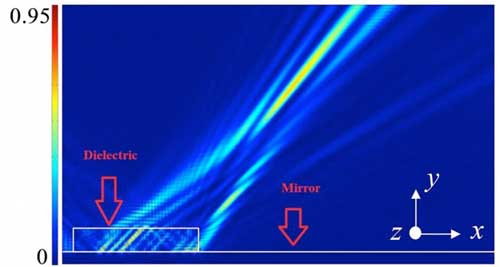| Jun 05, 2020 | |
Researchers experimentally prove flat mirror ability to focus light(Nanowerk News) For the first time, researchers of Tomsk Polytechnic University jointly with teams from Taiwan and Spain have experimentally confirmed the flat focusing mirror effect, which was previously predicted by them. |
|
| Physical properties of the effect and simplicity of its reproduction make it promising for application in microelectronics, photonics, and the on a chip systems, where a single microcircuit functions as an entire device. | |
| The study results are presented in Scientific Reports ("Experimental observation of flat focusing mirror based on photonic jet effect"). | |
 |
|
| Simulation results of normalized power flow patterns for the flat dielectric thin rectangle in reflection mode at incident angles 45°. The incident wavelength for the thin rectangle is 405 nm. (© Scientific Reports) | |
| The flat focusing mirror effect based on a photon jet formed in the reflection mode was theoretically explained in several previously published papers. | |
| “Mirrors are used to focus radiation. The most common example is a flashlight. A parabolic mirror inside it focuses light and an ordinary flat mirror can not. However, it turned out that it can be modified in an extremely simple way,” Prof. Igor Minin, project manager, the TPU Division for Electronic Engineering, says. | |
| We managed to make a flat mirror to focus light using a micro-sized pieces of a dielectric material, for instance, glass. | |
| “In the experiments, we used pieces of a rectangular shape, however, the shape is not important. When light falls on this piece, the reflected radiation is focused in the form of a photon stream. We have managed to prove this experimentally,” Igor Minin explains. | |
| In practice, this effect simplifies the use of flat mirrors for focusing. | |
| “We do not need to change mirror shape and the focusing process is extremely simple. We only need a mirror, dielectric pieces, and a radiation source. It is important that we can use a compact mirror. Unlike a curved one with the same parameters, flat mirrors are much easier to produce. Thus, it can be used in miniature devices and due to its simple shape, it can be easily combined with other elements. These are advantages compared to both curved mirrors and other focusing methods,” the professor underlines. | |
| In the future, the research team plans to carry out studies in the application of this effect, for instance, to manipulate nanoparticles and transmit optical information. |
| Source: Tomsk Polytechnic University | |
|
Subscribe to a free copy of one of our daily Nanowerk Newsletter Email Digests with a compilation of all of the day's news. |
